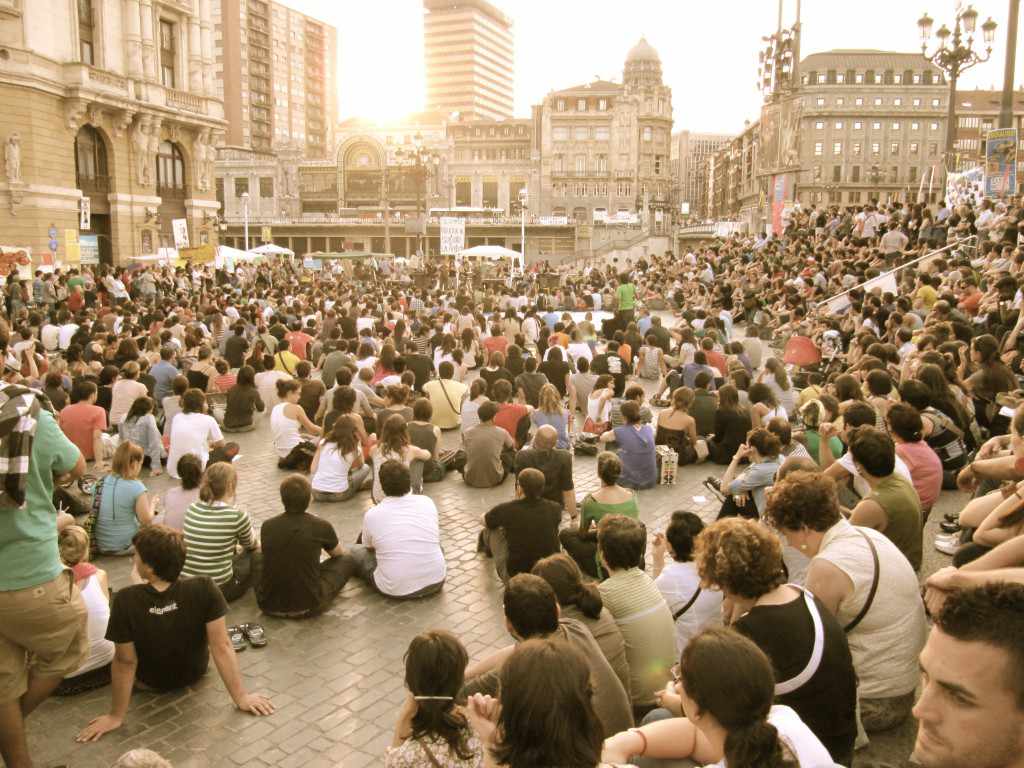by CarEnvy.ca
Controversy equalizes fools and wise men – and the fools know it. -Oliver Wendell Holmes
Take US Politics, the closest thing America has to a Mexican telenovela, where one person’s ignorance is just as valuable as another person’s knowledge. Both parties, both heads of the same lobby-fueled dragon, revel in the afterglow of a suitably stirring controversy – anything to undermine their opponents rather than fight for the electorate on their own merit.
Sidenote: If you’re interested in listening to some rather unapologetic debate, try The Brothers Dushenski podcast featuring your humble author. It’s a weekly look at this crazy world we live in, including technology, world affairs, global politics, sports, and other things of interest.
The scene above, taken last month in Bilbao, Spain outside the Teatro Arriaga, was a similar hub of dispute. Hundreds, if not thousands, gathered to voice their discontent at the EU, international banks, and the country’s political parties. These micro-revolutions have been sprouting up all over Spain, and are spreading to other parts of Europe as well, most notably in Greece. They are as controversial for their initial presence as they are for their staying power and civility, even in the face of brutality. The problem was that they didn’t have anything resembling a unified message. Instead of banding together in something resembling a civilized organization, the whole discontented movement floundered in its own self-pity. It was controversy, but whether they were fools or wise men still isn’t clear, though the dust has settled.
In the Basque region of northern Spain, where ETA separatists have long given a tangible tension to the salty air coming off the Bay of Biscay, two designs attract similar cause célèbre. Neither of which has yet beaten back naysayers completely.
One of these two is more permanent, y’know, since it’s a freakin’ building. The Guggenheim Bilbao, completed in 1997 and designed by Canadian-born architect Frank Gehry (he of Dancing House in Prague, Walt Disney Concert Hall in LA, and EMP in Seattle), is the crowning jewel of the tenth largest city in Spain. Its crumpled and contrary aesthetic serves as a titanium beacon for the city’s animated art scene. Still, it divides not only popular opinion, but that of those in the know.
In the shadows of the icon, your venturous author discovered a similarly contentious work. Although no bigger than a VW Golf, the MINI Countryman attracts the kind of spirited parley that you’d expect at a G20 summit. Even if the Black Bloc is noticeably absent from the local BMW/Mini dealer.
This darkly coloured Countryman belonged to an employee of the museum, a pre-middle-aged woman who accessorized her four-door Mini with flourishes of flashy chrome to match the environs of her work parking lot. The blacked-out wheels did little to diminish the appearance nor the reality of pseudo-off-road pretension. Instead, they accentuated the mocha hues of the paintwork.
But even the most beloved shade of paint couldn’t excuse the ALL4 box ticked by the woman. Spain’s roads have been immaculate ever since they entered the EU and the climate is better yet – even without, believe it or not, EU intervention. Even without the ALL4, we all understand that the Countryman exists to make money. To be fair, no business can accomplish its goals if it isn’t in business, but the Countryman does little to differentiate itself from other compact softroaders. Show me even a smidgen of the imaginative brilliance of Sir Alec Issigonis’ original and I’ll buy you a goldfish named Whale.
The protestors and the Guggenheim were at least there for the right reasons: because they want to make their world a better place. No one will ever say this of the Mini Countryman, no matter how many BMW successfully markets to culturally diverse homeboys.
Despite there being two birds of controversy here, I only wanted to kill one of them with a stone.
[Photo credit: author]



